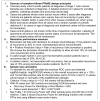Improving the quality of biomarker discovery research: the right samples and enough of them
- PMID: 25837819
- PMCID: PMC4452419
- DOI: 10.1158/1055-9965.EPI-14-1227
Improving the quality of biomarker discovery research: the right samples and enough of them
Abstract
Background: Biomarker discovery research has yielded few biomarkers that validate for clinical use. A contributing factor may be poor study designs.
Methods: The goal in discovery research is to identify a subset of potentially useful markers from a large set of candidates assayed on case and control samples. We recommend the PRoBE design for selecting samples. We propose sample size calculations that require specifying: (i) a definition for biomarker performance; (ii) the proportion of useful markers the study should identify (Discovery Power); and (iii) the tolerable number of useless markers amongst those identified (False Leads Expected, FLE).
Results: We apply the methodology to a study of 9,000 candidate biomarkers for risk of colon cancer recurrence where a useful biomarker has positive predictive value ≥ 30%. We find that 40 patients with recurrence and 160 without recurrence suffice to filter out 98% of useless markers (2% FLE) while identifying 95% of useful biomarkers (95% Discovery Power). Alternative methods for sample size calculation required more assumptions.
Conclusions: Biomarker discovery research should utilize quality biospecimen repositories and include sample sizes that enable markers meeting prespecified performance characteristics for well-defined clinical applications to be identified.
Impact: The scientific rigor of discovery research should be improved.
©2015 American Association for Cancer Research.
Figures
Similar articles
-
Study Design Considerations for Cancer Biomarker Discoveries.J Appl Lab Med. 2018 Sep;3(2):282-289. doi: 10.1373/jalm.2017.025809. J Appl Lab Med. 2018. PMID: 30828695 Free PMC article.
-
Power estimation in biomarker studies where events are already observed.Clin Trials. 2017 Dec;14(6):621-628. doi: 10.1177/1740774517723830. Epub 2017 Aug 4. Clin Trials. 2017. PMID: 28776405
-
A 15-gene signature for prediction of colon cancer recurrence and prognosis based on SVM.Gene. 2017 Mar 10;604:33-40. doi: 10.1016/j.gene.2016.12.016. Epub 2016 Dec 18. Gene. 2017. PMID: 27998790
-
Biomarker research with prospective study designs for the early detection of cancer.Biochim Biophys Acta. 2014 May;1844(5):874-83. doi: 10.1016/j.bbapap.2013.12.007. Epub 2013 Dec 17. Biochim Biophys Acta. 2014. PMID: 24361552 Review.
-
At the cross-roads of participatory research and biomarker discovery in autism: the need for empirical data.BMC Med Ethics. 2015 Dec 15;16(1):88. doi: 10.1186/s12910-015-0082-0. BMC Med Ethics. 2015. PMID: 26669759 Free PMC article. Review.
Cited by
-
Statistical inference for net benefit measures in biomarker validation studies.Biometrics. 2020 Sep;76(3):843-852. doi: 10.1111/biom.13190. Epub 2019 Nov 28. Biometrics. 2020. PMID: 31732971 Free PMC article.
-
The search for drug-targetable diagnostic, prognostic and predictive biomarkers in chronic graft-versus-host disease.Expert Rev Clin Immunol. 2018 May;14(5):389-404. doi: 10.1080/1744666X.2018.1463159. Epub 2018 Apr 19. Expert Rev Clin Immunol. 2018. PMID: 29629613 Free PMC article. Review.
-
The Clinical Utility of lncRNAs and Their Application as Molecular Biomarkers in Breast Cancer.Int J Mol Sci. 2023 Apr 18;24(8):7426. doi: 10.3390/ijms24087426. Int J Mol Sci. 2023. PMID: 37108589 Free PMC article. Review.
-
The Metabolic Signature of In Vitro Produced Bovine Embryos Helps Predict Pregnancy and Birth after Embryo Transfer.Metabolites. 2021 Jul 27;11(8):484. doi: 10.3390/metabo11080484. Metabolites. 2021. PMID: 34436426 Free PMC article.
-
Standard Operating Procedures for Biospecimen Collection, Processing, and Storage: From the Consortium for the Study of Chronic Pancreatitis, Diabetes, and Pancreatic Cancer.Pancreas. 2018 Nov/Dec;47(10):1213-1221. doi: 10.1097/MPA.0000000000001171. Pancreas. 2018. PMID: 30325860 Free PMC article.
References
-
- Pepe MS, Etzioni R, Feng Z, Potter JD, Thompson M, Thornquist M, et al. Phases of biomarker development for early detection of cancer. J Natl Cancer Inst. 2001;93:1054–61. - PubMed
Publication types
MeSH terms
Substances
Grants and funding
LinkOut - more resources
Full Text Sources
Medical



